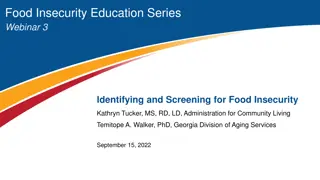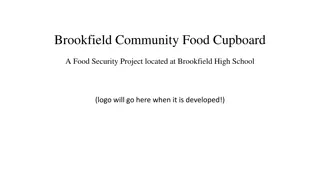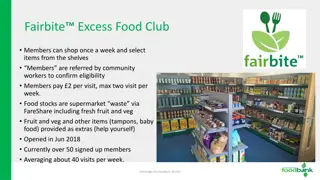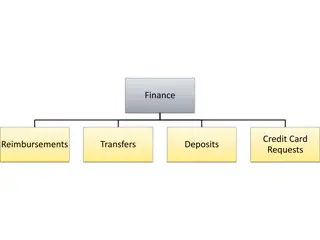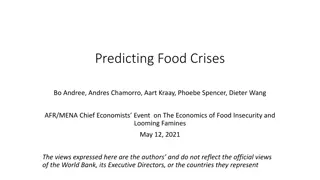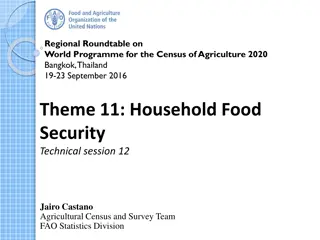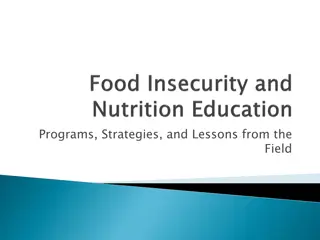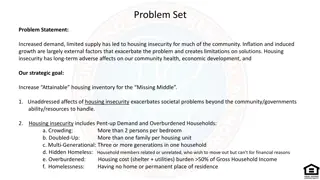Addressing Food Insecurity Among Underserved Communities in Allegheny County
High rates of food insecurity, especially among children, pose serious health and social risks in underserved communities like Braddock, PA. Home-based child care providers face challenges in providing healthy meals, exacerbated by factors like lack of participation in state programs. Ellen Lomax, a grandmother in Braddock, exemplifies the struggles faced by many caregivers in accessing nutritious food for children under their care. Addressing these issues is crucial to ensuring the well-being of vulnerable populations.
Download Presentation

Please find below an Image/Link to download the presentation.
The content on the website is provided AS IS for your information and personal use only. It may not be sold, licensed, or shared on other websites without obtaining consent from the author.If you encounter any issues during the download, it is possible that the publisher has removed the file from their server.
You are allowed to download the files provided on this website for personal or commercial use, subject to the condition that they are used lawfully. All files are the property of their respective owners.
The content on the website is provided AS IS for your information and personal use only. It may not be sold, licensed, or shared on other websites without obtaining consent from the author.
E N D
Presentation Transcript
fitUnited Pittsburgh Healthy Meals Home Delivery Grantmakers of Western Pennsylvania August 3rd, 2016
The Opportunity In Allegheny County 14.4% Food Insecurity Rate 18.8% Child Food Insecurity Rate Undernourished children are at risk of serious health, social and educational problems carrying into adulthood In our underserved communities or areas with LSA (low supermarket access) this is more pronounced: 56.4% of children in Braddock are living in poverty Braddock median household income: $22,924 Significant numbers of children in underserved communities are looked after by unregulated childcare providers classified as Relative/Neighbor providers
The Opportunity (cont.) Home-based child care providers in underserved communities face a number of challenges in providing healthy foods for children in their care: Storage and Time: shopping and storing food in a residential facility can be a challenge Lack of Participation in State Administered programs: very few Relative/Neighbor providers participate in CACFP (Child and Adult Care Food Program) Cost: those who do participate in CACFP report they spend more than the allowance. In Pennsylvania 5,300 children that we know of are cared for by Relative/Neighbor Providers 825 (or 15.5%) of those are in Allegheny County 2,214 (41.7%) are in Philadelphia
Relative/Neighbor Provider Profile Ellen Lomax A Grandmother living in Braddock PA Cares full time for 2 of her grandchildren Ms Lomax does not have a car, and has physical mobility issues When we first met Ms Lomax, she was saving up to get the $12 she needed for the jitney to take her to the supermarket She uses coupons which often dictate which store she shops at and she tries to keep her pantry stocked with shelf-stable items in case she has trouble getting the jitney money together We were Ms Lomax s only means of support during the pilot, and she often talked to us about troubles she was having unrelated to food and nutrition
The Opportunity (cont.) Relative/Neighbor Providers Receiving Child Care Subsidies based on eligibility of parents They qualify for CACFP but few participate Caring for children in an unregulated and unmonitored environment no assessment of: Safety Air quality Programming Nutrition November 2016 they will need to be certified, but only if looking after unrelated children
Our Average Provider 4 Children Many are providing more than 2 meals and a snack Only 1/3 of providers were meeting recommended servings of fruits/vegetables Almost 50% rely on a friend or public transportation to go food shopping 78% cite challenges in accessing food Average provided less than 1 full serving of fruit/vegetables a day 65% serve fast food to the children Meals Served Snack Dinner Lunch Breakfast 64% 66% 68% 70% 72% 74% 76% 78% 80% 82% 84%
The Solution Bring fresh, healthy food to the doors of home-based childcare providers Included key stakeholders in the targeted community of Homewood: Homewood Children s Village, Greater Pittsburgh Community Food Bank, YMCA and YWCA Create long-term, sustainable program by using Federal reimbursement dollars For $22.70, deliver a weeks worth of groceries per child to their door
The Solution (cont.) Significant testing and learning started with our first pilot in 2014 Phase I: Heinz/Grable/Eat n Park Prepared Meals Homewood Phase II Heinz/Grable/Eat n Park Groceries Added Hazelwood Phase III Hillman Foundation Groceries 6 Neighborhoods
The Solution (cont.) Pilot 1: Summer 2014 Funded by Eat n Park Hospitality Group, Heinz Endowments, Grable Foundation Prepared Meals for 55 children in Homewood Lessons learned incorporated into next pilot Pilot 2: Summer 2015 Funded by Eat n Park Hospitality Group, Heinz Endowments, Grable Foundation Delivered groceries for 127 children in Homewood and Hazelwood Pilot 3: March 2016 Funded by the Hillman Foundation Expand to 6 Neighborhoods 267 Children 55 Providers Homewood, Hazelwood, Braddock, Turtle Creek, Northside,
Healthy Meals Home Delivery Phase III 12 week program delivering healthy groceries weekly 55 home-based child-care providers in the North Side, Braddock, Turtle Creek, Homewood, Hazelwood & Wilkinsburg Serving 267 children every week Partnering with the Greater Pittsburgh Community Food Bank (procurement and repack), Mission Logistics (delivery), GoShadow (data gathering and optimization tool), PAEYC (identifying childcare providers) 7,500lbs of food - 13,000 individual pieces of fruits and vegetables
Sample Weekly Menu Monday Tuesday Wednesday Thursday Friday 1% Milk / Toasted O s / Canary Melon Slices 1% Milk / Pancakes / Apple slices 1% Milk/ Wheat flakes / Banana 1% Milk/ Oatmeal/ Apple Sauce 1% Milk/ Scrambled Eggs with whole wheat toast/ Kiwi Breakfast 1% Milk / Grilled Cheese on whole wheat toast / Carrot soup / Kiwi 1% Milk / Sticky chicken drumsticks / macaroni and cheese / coleslaw / canary melon 1% Milk / chicken bean bake with brown rice 1% Milk / smoked turkey drums / carrot slaw / apple slices / whole wheat toast 1% Milk / zucchini-carrot patties / brown rice with black beans Lunch Water / granola bar / apple slices Water / hard boiled egg / whole wheat toast Apple / Cinnamon O s / Orange Juice Water / Banana with peanut butter Water / apple / whole wheat toast with peanut butter Snack
Measures of Success 1. Demonstrate ability to meet or exceed quantities needed per child per week 1. 97% of providers confirmed they had food left over every week Ensure we are delivering healthy meals for children 1. 82% of providers were providing 2-4 servings of fruits and vegetables during the day (increase from 58% before the program) Engage Relative/Neighbor Providers in chosen communities 1. 90% of our providers were Relative/Neighbor providers (target 10%) Ensure the program can be scaled 1. Add 3 new communities: we added four new communities: Braddock, North Side, Wilkinsburg and Turtle Creek 2. Provide food for 240 children per week: we were delivering for 267 children every week 2. 3. 4.
Key Underserved Neighborhoods Poverty rates range from 21.3% to 31.2% Percentage of children living in poverty Homewood 43.1% Hazelwood 36% Braddock 56.4% Turtle Creek 29.8% Northside 36% Wilkinsburg 43.2% On average, 23.62% of residents are on SNAP Median household income ranges from $23,403 - $39,707 Homewood Wilkinsburg North Side Turtle Creek Hazelwood Braddock Yellow shading represents USDA classified Food Desert
Key Underserved Neighborhoods A total of 55 Providers
Weekly Budget vs Costs Daily CACFP Allowance: Maximum of $4.54 per child per day 2 Meals and 1 Snack
Comprehensive Reports GoShadow offers a variety of comprehensive reports, including time studies, accolade and opportunity reports and experience flow maps. Generated with one touch, the GoShadow reports aggregate and display shadowing data. The reports allow for ease in understanding a process, identifying areas for improvement and the alignment of goals.
Repack Process Week 10 Repack: 2 children per minute 11-12lbs per child Clean/Set Up 40 mins (week 10) Potential Capacity: 360 Children every 3 hours
Delivery Process Braddock Total Drive Time Week 1: 5h15 Braddock Total Drive Time Week 11: 1h55 Key Factors: Provider Home Provider Ready/Waiting Driver Efficiency
Program Satisfaction Sufficient Food 92% were satisfied with the quality of food each week 100 80 95% liked the weekly menus and 87% used the menus provided each week 60 40 20 100% reported that the program has been helpful 0 Breakfast Lunch Snack Braddock provider: "Program helped because I didn t have to stretch my food stamps to purchase food for the kids.
Health and Nutrition Daily Servings of Fruits & Vegetables Increased 82% 58% Servings of 2 or more fruits & vegetables increased from 58.4% to 82% 89% reported that the program introduced children to new foods Hazelwood provider: The program allows them to eat more fresh fruits and vegetables because usually those foods are to expensive to buy.
CACFP Reimbursement Only 5 providers were currently on CACFP 91% were interested in signing up for CACFP One provider who was previously enrolled in CACFP said: I used to be part of the program, and I know I wouldn t have been able to buy the amount and types of food you gave us on that program. Other reasons providers would prefer deliveries: I don t have the funds to buy groceries and get reimbursed later. I would prefer deliveries because then I know the money is going for food. WOULD YOU GIVE UP REIMBURSEMENT? Yes 89%
Provider Highlight Nicole Glaze Group provider in Braddock Cares for 12 children Was spending $500/month on groceries Did not shop while enrolled in the program Served fruit once per day before, and served it 2-4 times/day during program The program was everything to me and everyone should be a part of it. It helped me get my center running, provide healthy food for the kids, and direct my energy toward other aspects of the childcare. The program gave me the ability to feed kids before school and fill babies stomachs who would come hungry. The deliveries have helped her sustain her childcare facility and kids are always excited when deliveries come!
Additional Provider Feedback Braddock provider: The meals have gotten healthier during the deliveries because the food delivered had fresh fruit and vegetables, where before I only bought canned. Braddock provider: Through the program I learned how to cook healthier and my grandkids were eating things I never thought they would. The Program has totally transformed the way I cook and is much healthier.
Additional Provider Feedback Northside provider: Didn't have to spend money on food and could put money towards activities like science center, ice cream, resources could be used differently in general. Less pressure on her to come up with food ideas and allowed her to teach kids about healthy food and trying new things. Northside provider: Given her the opportunity to provide additional food and more importantly healthy, nutritious food. Program has been educational and teaches how to eat healthier and give healthier food to kids.
Additional Provider Feedback Braddock Provider: The meals I served definitely got healthier. Gave me the chance to get a lot of things since when I do my own shopping I would run out of food between trips and this program prevented that. Turtle Creek Provider: the groceries were a huge help, she usually uses her own money to buy the food for her grandchildren whom she looks after so that her daughters reach their dreams . She told us it was so special that we could be there to help her and her family.
Conclusions/Next Steps Demonstrated potential to scale and sustain within CACFP budget Challenges: Repack is a complicated and sometimes time- consuming process Unintended Benefits/Consequences Tracy has a 29 year old autistic son Tyrell that who lives with her in her North Side home. He used to let us in every week. We learned that Tyrell used to be involved with an employment/mentoring program through the Carnegie Library, but stopped going because he was being picked on by neighbourhood kids at the bus stop. fitUnited was able to link Tracy with the Office of Vocational Rehab to get Tyrell back into a working program A Provider ran into issues with landlord and was in and out of court due to rent payment disputes. She confided in us, we connected her with resources and agencies to start looking for affordable housing she told us she was extremely lucky to have us as support because she didn t know where else to turn for help Next Steps: Creating a plan to stay engaged with providers USDA Approval





